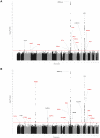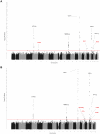Genome-wide association study identifies novel loci associated with circulating phospho- and sphingolipid concentrations
- PMID: 22359512
- PMCID: PMC3280968
- DOI: 10.1371/journal.pgen.1002490
Genome-wide association study identifies novel loci associated with circulating phospho- and sphingolipid concentrations
Abstract
Phospho- and sphingolipids are crucial cellular and intracellular compounds. These lipids are required for active transport, a number of enzymatic processes, membrane formation, and cell signalling. Disruption of their metabolism leads to several diseases, with diverse neurological, psychiatric, and metabolic consequences. A large number of phospholipid and sphingolipid species can be detected and measured in human plasma. We conducted a meta-analysis of five European family-based genome-wide association studies (N = 4034) on plasma levels of 24 sphingomyelins (SPM), 9 ceramides (CER), 57 phosphatidylcholines (PC), 20 lysophosphatidylcholines (LPC), 27 phosphatidylethanolamines (PE), and 16 PE-based plasmalogens (PLPE), as well as their proportions in each major class. This effort yielded 25 genome-wide significant loci for phospholipids (smallest P-value = 9.88×10(-204)) and 10 loci for sphingolipids (smallest P-value = 3.10×10(-57)). After a correction for multiple comparisons (P-value<2.2×10(-9)), we observed four novel loci significantly associated with phospholipids (PAQR9, AGPAT1, PKD2L1, PDXDC1) and two with sphingolipids (PLD2 and APOE) explaining up to 3.1% of the variance. Further analysis of the top findings with respect to within class molar proportions uncovered three additional loci for phospholipids (PNLIPRP2, PCDH20, and ABDH3) suggesting their involvement in either fatty acid elongation/saturation processes or fatty acid specific turnover mechanisms. Among those, 14 loci (KCNH7, AGPAT1, PNLIPRP2, SYT9, FADS1-2-3, DLG2, APOA1, ELOVL2, CDK17, LIPC, PDXDC1, PLD2, LASS4, and APOE) mapped into the glycerophospholipid and 12 loci (ILKAP, ITGA9, AGPAT1, FADS1-2-3, APOA1, PCDH20, LIPC, PDXDC1, SGPP1, APOE, LASS4, and PLD2) to the sphingolipid pathways. In large meta-analyses, associations between FADS1-2-3 and carotid intima media thickness, AGPAT1 and type 2 diabetes, and APOA1 and coronary artery disease were observed. In conclusion, our study identified nine novel phospho- and sphingolipid loci, substantially increasing our knowledge of the genetic basis for these traits.
Conflict of interest statement
The authors have declared that no competing interests exist.
Figures


References
-
- Holthuis JC, Pomorski T, Raggers RJ, Sprong H, Van Meer G. The organizing potential of sphingolipids in intracellular membrane transport. Physiol Rev. 2001;81:1689–1723. - PubMed
-
- Merrill AS, K Vance DV, JE, editors. Sphingolipids: metabolism and cell signaling. Biochemistry of Lipids, Lipoproteins and Membranes. 2002. pp. 373–407.
-
- Bakovic M, Fullerton MD, Michel V. Metabolic and molecular aspects of ethanolamine phospholipid biosynthesis: the role of CTP:phosphoethanolamine cytidylyltransferase (Pcyt2). Biochem Cell Biol. 2007;85:283–300. - PubMed
-
- Poli G, Leonarduzzi G, Biasi F, Chiarpotto E. Oxidative stress and cell signalling. Curr Med Chem. 2004;11:1163–1182. - PubMed

